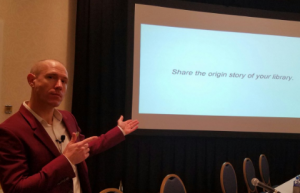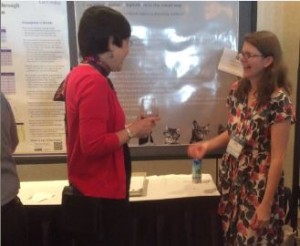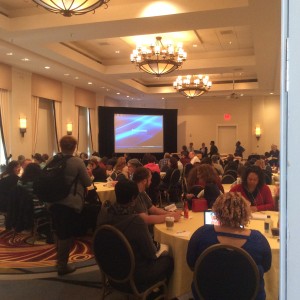On Friday, April 21, I remotely attended two CRL meetings.
Council of Voting Members Meeting
In CRL’s 2017 Council of Voting Members Meeting, participants considered recommendations by CRL’s Board and management for new measures and new investment in shared collections and related digital services, in accordance with CRL’s Agenda for Shared Print, 2017 – 2026. See here for the meeting’s full agenda.
In Scott Waugh’s Chair Report, he discussed CRL membership and explained that the number of CRL members has stayed about the same from last year to the current year. Two members have notified CRL that they will not be renewing their membership next year.
The most significant portion of the meeting was the President’s Report in which Bernard Reilly discussed important changes in direction for CRL. In his report, Reilly discussed and elaborated on information that he initially shared via a series of “Sea Change” posts that have appeared on the CRL blog over the past several months. In the print/microform arena, Reilly discussed a number of pressure points:
- New organizations and initiatives (he noted EAST as an example) are engaged in work to steward print resources on scales that are equal to or surpass CRL.
- Platforms such as JSTOR are expanding expectations for seamless access.
- Retrenchment: Some organizations scaling back print distribution/retention efforts
- There is a broken supply chain: channels for distribution of print and microform materials are stalling, falling apart.
- Vendors of microform are increasingly requiring license agreements that restrict how the microform content is used, including prohibiting interlibrary loan. Other vendors have simply stopped producing microform.
The digital arena has its own set of pressure points:
- Government information is proliferating on growing scales.
- Information is being privatized. This is tilting access away from academia and toward the corporate sector.
In response to these pressure points, Reilly discussed new directions:
- In the print/microform arena, the CRL Agenda for Shared Print (2016-26) calls for:
- Increased focused on print materials in the humanities and social sciences.
- Supporting the need of libraries to responsibly but rapidly manage-down their print collections.
- Extending CRL’s partnership with the Linda Hall Library.
- Exploring ways to combine resources and work collaboratively with other efforts to steward print (again, EAST was cited as an example).
- Ensure that preservation commitments are auditable and readily accessible.
- Working with CLOCKSS and Portico to expand preservation work to address the long-tail of information resources.
- In the digital arena, CRL is focusing on:
- Preservation of content outside of—but relevant to—academic research (financial, news, governmental, geospatial).
- Collectivizing digital content, ensuring that the content can be licensed in ways that reflect library standards and expectations.
Reilly discussed how the CRL will direct the fiscal and organizational resources needed to enable these new directions. CRL plans to wind-down certain of its former activities, ensuring that their focus is on meeting member-driven needs over just-in-case activities. For example, CRL is planning to cancel its print subscriptions to about 400 serials. Most of these subscriptions began in the 1980s, are rarely used, and are on topics outside of CRL’s main focuses for collecting. CRL is planning to stop routinely buying certain foreign newspapers (again, there is very little demand) and will no longer purchase microform of materials with licenses that prohibit interlibrary loan. In response to the news about the cancellation of subscriptions, an attendee asked if CRL has analyzed overlap between the cancelled titles and the holdings of member libraries. CRL responded that there has been some investigation but no systematic analysis. The initial bases for placement of the subscriptions was the fact that the titles were scarcely held, so CRL speculates that overlap is not substantial. Another attendee asked for a list of the cancelled serials and CRL said that such a list could be posted on the CRL website.
Following the President’s Report, Xuemao Wang gave the Treasurer’s Report. The most important topic here was the proposed CRL budget for FY2018. A number of attendees expressed concerns about endorsing the FY2018 budget without a better understanding of and more details concerning changes in CRL’s directions. Reilly attempted to address these concerns, emphasizing that CRL’s new directions do not map to specific items in the proposed budget. The budget was approved, with 70 in favor and 19 opposed.
CRL Global Resources Collections Forum
This forum consisted of two sessions, one on licensing global data and the other on digitizing global collections. Each session included a series of short presentations.
The first session was framed as a continuation of the discussion that occurred at the “Licensing Big Data” online forum that CRL hosted in November 2016. James Simon (CRL Vice President for Collections & Services) began by discussing ideas for the best avenues through which the CRL can deal with vendors of global data. He discussed the advantages (e.g., leveraging strengths and buying power; standardizing terms and use rights; promoting transparency; ensuring accountability of providers) and disadvantages (no one-size-fits-all approach; different levels of interest and needs among CRL libraries; diluted agency for negotiation among individual institutions; speed/timing) of centralized licensing through the CRL. He then discussed how best to frame the CRL’s role, emphasizing the key question of if/how best can CRL bring value to this problem space for its members. Greg Raschke of North Carolina State University provided a brief response to Simon’s presentation, noting that CRL should stay away from duplicating the licensing efforts of individual member libraries and “go big or go home” by striving to aggressively tilt the overall marketplace in directions that member libraries would benefit from.
Following Simon’s presentation, Lara Cleveland (Integrated Public Use Microdata Series-International, IPUMS) gave a short presentation on IPUMS, which is an organization that collects, aggregates, provides access to, and stewards census micro data. She discussed some of the hurdles that IPUMS faces as they attempt to license their content and also new directions, such as digitizing census results and integrating the contents of Integrating International Labor Force Surveys.
Susan Powell (Berkeley) then presented on supporting library dealings with vendors and sources of GIS data. Powell discussed some of the challenges associated with GIS data, including the variety of delivery and access mechanisms, the reliance on proprietary software, and the problematic manners in which authorized users are defined. Powell advocated for licensing GIS data in manners that allow users to manipulate data, copy it, and make derivative works based on it. She also discussed challenges of making GIS data discoverable and how to benchmark the value of this data. She said that CRL could have a role in the GIS data problem space through the development of a model license.
The forum’s second session focused on digitizing global collections. Reilly began the session by giving an update on CRL’s digital resource-building activities. Next, James Simon gave a progress report on CRL’s Global Collections Initiative, which is an Andrew W. Mellon Foundation-funded initiative to develop a framework for supporting international studies. More specifically, the initiative aims to create a sustainable apparatus for e-access to primary source document, establish an internal framework for collectively dealing with publishers, and assess web archiving practices. The initiative will be in a development phase until 2018, during which period the focus will be on Latin America materials.
Recordings of presentations will be available on CRL YouTube channel in coming weeks
CRL’s next annual meeting (April 2018) will be an in-person event and the topic of the forum following the meeting will be global data. Also, CRL will be hosting a forum at the 2017 ALA Annual Conference regarding future priorities for the organization.









